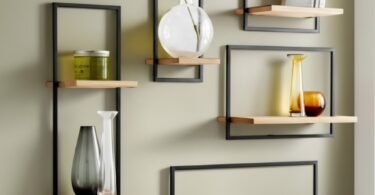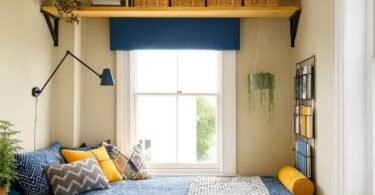
Let me tell you something about shelves. Every single home I’ve ever walked into has them. Doesn’t matter if we’re talking about a cramped studio apartment where you can touch opposite walls while standing in the middle, or some sprawling estate with more rooms than anyone knows what to do with. Shelves just exist everywhere, like coffee mugs or that random drawer full of batteries that may or may not work.
What makes shelves so universal? They’re practical, sure. But they’re also one of those rare things that can make a space feel more organized while simultaneously making it look better. I’ve seen people transform their entire living room vibe just by adding the right shelving. It’s like giving a room a personality transplant without the commitment of painting walls or buying new furniture.
Now, if you’ve spent any time scrolling through home design feeds lately, you’ve probably noticed floating shelves popping up everywhere. And I mean everywhere. They’ve gone from being this niche designer thing to mainstream must-haves. The reason? They work with pretty much any style you can throw at them. Got a minimalist thing going on? Floating shelves fit right in. Prefer something more industrial or rustic? Yep, they work there too.
What I love most about floating shelves is how they trick your eye. They create this illusion of space that regular shelving just can’t match. When you mount a traditional shelf with visible brackets, your brain registers all that hardware. But floating shelves? They make whatever you put on them look like it’s defying gravity. Books, plants, your collection of vintage cameras… everything looks just a bit more interesting when it appears to be hovering against the wall.
The versatility is kind of insane when you think about it. I’ve installed floating shelves in my bathroom to hold towels and toiletries. My kitchen has a few holding spices and oils. The living room got some for books and succulents. Even stuck one in the hallway just because there was this awkward empty wall that needed something. Each one serves a different purpose, but they all tie the space together in this cohesive way.
Here’s what really sells me on them, though. You can start small. Buy one shelf, put it up, see how you like it. Don’t like where it is? Move it. Want to add more? Go for it. There’s no commitment to some giant shelving unit that you’re stuck with once it’s assembled. You’re building your storage as you go, adapting to what you actually need instead of what some furniture designer thought you might need.
The DIY aspect makes them accessible too. I’m not exactly a master carpenter, but I’ve managed to install every floating shelf in my place without calling in reinforcements. Most come with mounting hardware that’s pretty straightforward. You need a drill, a level, maybe a friend to hold things steady while you mark where the holes go. That’s about it. An afternoon project that instantly upgrades your space.
I’ve also noticed they work wonders in rooms where floor space is precious. Small bedrooms, tight bathrooms, compact home offices… places where a standing shelf unit would just eat up too much room. Floating shelves give you that storage and display space without sacrificing square footage. They draw the eye upward, making ceilings feel higher and rooms feel more open.
But let’s be real for a second. Not all floating shelves are created equal. I’ve bought cheap ones that started sagging within months. The particle board warps, the finish chips, and suddenly your floating shelf looks more like a drooping shelf. Learned that lesson the hard way. Now I stick with solid wood or quality materials that can actually handle weight without throwing a fit.
The style factor can’t be ignored either. There’s something inherently modern about a floating shelf, but you can dress it up or down depending on what you put on it. Load it with leather-bound books and brass accents? Suddenly it’s traditional. Fill it with geometric planters and abstract art? Now it’s contemporary. Stack some mason jars and reclaimed wood boxes? Hello, farmhouse chic. The shelf itself stays neutral, letting your stuff do the talking.
You know what else I appreciate? They’re commitment-phobic in the best way. Unlike built-in shelving that requires actual construction and probably a permit, floating shelves can come and go as your style evolves. That matters when you’re renting, or when you’re someone like me who gets bored with the same look after a year or two. Fresh paint and rearranged shelves can make a place feel brand new without breaking the bank.

What Are They Like?
So what exactly makes a floating shelf float? It’s not magic, though it kind of looks like it. The secret is in how they mount to your wall. Unlike traditional shelves with those visible L-brackets underneath, floating shelves use hidden mounting systems. Usually, there’s a metal rod or plate that gets anchored into the wall, and the shelf slides over it. The weight-bearing hardware stays hidden inside the shelf itself.
This creates that clean, streamlined look where the shelf appears to emerge directly from the wall. No brackets breaking up the visual line. No screws visible from below. Just a smooth, continuous surface that makes your wall look less cluttered and more intentional. Your eye focuses on what’s on the shelf instead of how the shelf is staying up.
The mounting process matters more than people think. You can’t just slap one of these up anywhere. Studs become your best friends. Those vertical wood beams behind your drywall? That’s where the real support comes from. I learned this after my first attempt at mounting a floating shelf into just drywall with anchors. Put a few books on it, heard a concerning creak, and quickly redistributed the weight before disaster struck. Now I always find the studs first.
Some floating shelves come as individual pieces. You buy one, mount it, done. Others come in sets designed to be arranged together. I’ve seen some really cool asymmetric arrangements where someone used three or four shelves of different lengths at varying heights. It creates this dynamic, almost sculptural thing on the wall. Way more interesting than the standard stacked-shelf approach.
Then there are these newer styles that take the floating concept even further. Picture this… a shelf suspended from the ceiling with thin cables. It hangs in space, not touching the wall at all. The first time I saw one, I genuinely did a double-take. They look like they’re levitating in mid-air, which opens up completely different possibilities for how you use your space.
These ceiling-mounted versions don’t need wall support, which means you can position them anywhere in a room. Want to create a subtle room divider without building a wall? Hang a couple of these shelves between your living area and dining space. They define the zones without blocking light or making the space feel chopped up. I saw someone do this in an open-plan loft, and it completely transformed how the space felt and functioned.
The cable suspension gives them this light, airy quality too. Where a traditional floor-to-ceiling shelf unit can feel heavy and imposing, these suspended shelves maintain that sense of openness. They float not just visually but literally, held up by these thin wires that barely register when you look at them. Your brain focuses on the shelf and what’s on it, not the support system.
Installation gets a bit trickier with ceiling-mounted options. You’re dealing with ceiling joists now, which can be harder to locate than wall studs. And you need to be absolutely certain about weight distribution. But if you can pull it off, or if you’re willing to hire someone who knows what they’re doing, the payoff is worth it. You get this furniture piece that feels like it’s from the future.
Material choices run the full spectrum. I’ve seen floating shelves in reclaimed barn wood that bring serious rustic warmth to a space. Sleek white lacquered ones that disappear into modern walls. Thick slabs of walnut with live edges that make a statement all on their own. Metal and glass combinations that work great in industrial settings. The shelf itself becomes part of the design, not just a functional afterthought.
Thickness matters too. Those ultra-thin shelves (like an inch thick) give you maximum floating illusion but can’t hold much weight. Thicker shelves (two to four inches) can support heavier items and make more of a visual statement. I’ve got a chunky three-inch oak shelf in my office holding a printer and a bunch of books. Doesn’t budge, doesn’t sag, looks like it grew out of the wall.
Length is another variable to play with. Short shelves (under two feet) work great in tight spaces or for creating little display moments. Medium lengths (three to five feet) are the workhorses, perfect for most rooms. Long spans (six feet or more) make bold statements but need serious support. I watched a friend install an eight-foot floating shelf for his vinyl collection. Took four mounting points and some engineering calculations, but now it’s the centerpiece of his living room.
Corner floating shelves deserve a mention. These wrap around inside corners, using space that often goes wasted. Perfect for small bathrooms or tight kitchens where every inch counts. They feel especially clever because they solve a real problem while looking good doing it. I put one in my bathroom corner to hold all those bottles that were cluttering my shower, and it freed up so much space.
Some designs incorporate lighting. LED strips along the underside create this warm glow that highlights what’s on display while providing ambient light. Seen this done really well with shelves holding glass collections or colorful ceramics. The backlight makes everything pop. It turns functional storage into actual art installation territory.
The wood grain direction makes a difference too. Shelves cut with the grain running lengthwise show off natural wood patterns better and tend to be stronger. End grain shelves (where you see the growth rings) create interesting visual texture but need more careful mounting. These details seem small until you’re staring at the shelf every day.
Depth is your flexibility factor. Shallow shelves (six inches or less) work for small items and tight spaces without protruding too far into the room. Standard depth (eight to ten inches) fits most books and decor. Deep shelves (twelve inches plus) can hold bigger items but start to eat into your space. I’ve got a mix throughout my place, matched to what each spot actually needs.
You can find floating shelves with integrated features now too. Some have built-in charging stations hidden in the back. Others include small drawers or cubbies within the shelf structure. There are versions with hooks underneath for hanging stuff. The basic floating shelf concept keeps evolving into these multi-functional pieces that do more than just hold things.

Very Functional
Let’s talk about what floating shelves actually do for you beyond looking good. The functionality is where they really prove their worth. Any shelf serves the basic purpose of holding stuff, but floating shelves bring some specific advantages that make them stand out from traditional options.
First off, they’re space savers in the truest sense. Because they mount directly to the wall with no floor footprint, they work in places where regular furniture won’t fit. That narrow wall in your hallway? Perfect for a floating shelf. The space above your toilet? Prime real estate for a shelf. That awkward nook in your bedroom? You get the idea. They colonize vertical space that would otherwise just be empty wall.
In bathrooms, floating shelves are game changers. I replaced my bulky cabinet with three floating shelves, and suddenly the whole room felt bigger. They hold towels, toiletries, and all the miscellaneous stuff that accumulates in bathrooms, but they don’t create that closed-off feeling that cabinets do. You can see what you have, grab what you need, and the room still breathes.
Kitchens benefit big time too. I’ve got floating shelves holding my everyday dishes, glasses, and coffee mugs. They’re easier to access than cabinets (no doors to open), and they force me to keep things organized since everything’s on display. Plus, there’s something homey about seeing your dishes and glassware arranged nicely on open shelving. Makes the kitchen feel lived-in rather than sterile.
Living rooms are the obvious application, but the ways you can use floating shelves there go beyond just holding books. I’ve seen people create entire media centers with floating shelves at different heights. Components on one level, games and remotes on another, decorative items scattered throughout. It’s modular storage that you can customize exactly to your setup.
Bedrooms get interesting because floating shelves work as nightstand alternatives. Mount one on either side of your bed, and you’ve got spots for lamps, books, phones, whatever you need at arm’s reach. Takes up zero floor space, which matters in smaller bedrooms. My friend did this in his tiny bedroom, and it made the room feel way less cramped than traditional nightstands would have.
Home offices might be where floating shelves shine brightest for functionality. You can create custom storage that fits your exact workflow. Shelf for reference books here, one for supplies there, another for decorative stuff that makes the office feel less office-y. I’ve built my whole office storage system around floating shelves, and I can reconfigure it anytime my needs change. Beats the heck out of being stuck with whatever configuration came with a pre-made desk unit.
The weight capacity thing needs addressing. A properly installed floating shelf can hold way more than people expect. I’ve got one holding about 50 pounds of books, no problem. The key is using the right anchoring system for your wall type and making sure you’re hitting studs when possible. Hollow wall anchors work for lighter loads, but anything substantial needs stud support.
Distribution of storage across multiple rooms is where things get creative. You can use floating shelves to create a consistent design language throughout your home. Same style shelf in the bathroom, bedroom, and living room ties everything together visually while serving different functions in each space. It’s like a design thread running through your place.
Adjustability is another functional win. Don’t like where you put it? Take it down, patch the holes, move it somewhere else. Try doing that with built-in shelving. I’ve moved my floating shelves around more times than I can count, trying different arrangements until something clicks. That freedom to experiment without permanent commitment is liberating.
They work great for renters too. Most landlords are cool with a few holes from shelf mounting (check your lease, though). When you move out, patch and paint, and you’re good. You get the benefits of customized storage without modifying the space in ways that violate your rental agreement. I rented for years, and floating shelves made those apartments feel like mine.
The open design helps with air circulation too, which matters more than you might think. In humid climates or rooms with poor ventilation, having air flow around stored items prevents mold and mustiness. Cabinets and closed storage can trap moisture. Open floating shelves let everything breathe. My books are way happier on open shelves than they were in my old enclosed bookcase.
You can layer your storage needs on floating shelves. Bins and baskets on the shelves contain smaller items while looking intentional. I use woven baskets on some of my shelves to hide less attractive stuff like cords and chargers. The baskets look nice, the shelves look organized, and I don’t have to stare at cable clutter all day.
Accessibility is better with floating shelves. Everything’s at eye level (or wherever you mount them), which beats bending down to low cabinets or reaching up to high ones. I mounted shelves in my pantry at heights that make sense for what goes on them. Heavy stuff low, lighter stuff higher, everyday items right in the sweet spot where I can grab them without thinking.
Cleaning is ridiculously easy. Dust the shelf, dust what’s on it, done. Compare that to cleaning around and inside cabinets with all their corners and enclosed spaces. I can clean all my floating shelves in about ten minutes. Makes me way more likely to actually do it regularly.
They’re great for displaying collections in ways that make them part of your decor. Someone I know collects vintage cameras and has them arranged on floating shelves in his office. They’re protected, displayed, and they make the room interesting. Same concept works for anything you collect, from vinyl records to ceramic mugs to action figures.
The psychological impact of organized, visible storage shouldn’t be underestimated. When your stuff has designated spots and you can see where everything is, life feels more manageable. Floating shelves make organization visible, which helps you maintain it. Hidden storage lets chaos accumulate out of sight. Open shelving keeps you honest.
Kids’ rooms benefit from floating shelves mounted at kid height. They can reach their books, toys, and supplies independently. Teaches organization skills while giving them ownership over their space. Just make sure they’re anchored really well because kids will absolutely test the weight limits in ways adults wouldn’t think to.
You can create zones within a room using floating shelves as subtle dividers. Mount a series of shelves perpendicular to a wall, and you’ve got a see-through partition that defines space without closing it off. Works great in studio apartments or open floor plans where you want some separation without losing light or sightlines.
The cost-effectiveness matters too. Good floating shelves aren’t cheap, but they’re way less expensive than custom built-ins or fancy furniture units. You can start with one or two, see how they work for you, and add more over time as budget allows. Building your storage gradually makes the cost more manageable than dropping big money on a complete furniture set all at once.








Leave a Comment